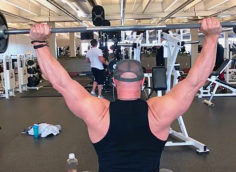Never let a powerlifter or Olympic lifter hold a baby. A bodybuilder can hold a baby, sure, but not powerlifters or O lifters.
A bodybuilder would gently bounce him up and down while making googly sounds. His weightlifting cousins, however, would likely take the baby and explosively thrust the poor little bugger off their chest or over their heads, wait for white lights that will never come, and then dejectedly drop the baby onto the pavement. Horrible.
This disparity in baby holding results from bodybuilders generally paying attention to the eccentric or lowering part of a movement while his weightlifting cousins generally ignore that portion of the lift.
Powerlifters and Olympic lifters just want to lift or hoist (the concentric part of a movement) as much weight as possible from the earth and they don't care a whit how it gets back down.
Bodybuilders vs. Powerlifters and Olympic Lifters
Many of us used to think that this dedication to both parts of the lift, the raising and the lowering, was why bodybuilders had extreme musculatures while powerlifters and O lifters looked either portly or kinda-sorta normal.
The lowering of the weight, slowly or just under control, causes muscle trauma, which in turn leads to the birth or recruitment of nascent muscle cells known as satellite cells. Bring enough of them on line, and you've reconstructed your muscles to be bigger and badder.
We now know there's much more to growing muscle than just employing the eccentric part of a lift and recruiting satellite cells, but it's still a huge part of the process. Just how much of a role does it play, though? Muscle scientist and T Nation contributor Brad Schoenfeld and his colleagues wanted to know, so they did a meta-study on the subject.
What They Did
Schoenfeld and his cohorts found 15 studies where participants had either done nothing but concentric lifting or nothing but eccentric lifting for a set period of time. They then threw all of the results into a hat and looked for any conclusive findings or trends.
You're probably wondering how they did a study where participants only did eccentric training. Concentric-only training is easy – test subjects just lifted the weight and let it fall courtesy of gravity before doing another rep, like most powerlifters and O lifters.
Eccentric-only is a little trickier. The scientists had to get spotters to lift the weights for the participants before they lowered them using their own power.
What They Found
Concentric-only training led to approximately a 6.8% increase in muscle growth across the board, while eccentric-only training led to a 10.0% increase.
While this 3.2% increase seems like sumthin' to normal, non-scientist type people, it's not deemed statistically significant; almost significant, but not quite.
Still, Schoenfeld had this to say about the findings:
"Given the modest effect size differentiation between exclusively eccentric and concentric training, it appears that eccentric-only training likely provides a small advantage over concentric-only training for promoting a hypertrophic response; not withstanding, both contraction modes can promote significant muscular hypertrophy."
And then he said what every PhD the world-over has sworn to say upon observing any effect no matter how obvious, "Further study is required..."
What This Means to You
Experientially at least, those of us who've been training and studying for a long time can tell you that controlling the eccentric portion of a movement tends to be more important to hypertrophy. And when we talk about "controlling" the movement, we're not implying that it always has to be a slow lowering of the weight, just controlled.
However, so many bonehead bodybuilders can't make up their minds if they want to grow muscle or push higher numbers just so they'll feel better about themselves. They explode a weight up – as they should – but in order to build up enough momentum to do another rep, they often let the weight come plummeting down and use the stretch reflex (plyometric force) to allow them to do another worthless rep.
Respect the eccentric and concentric equally. Explosive up and controlled down. Otherwise you're literally half-assing it.
Source
- Brad J. Schoenfeld; Dan I. Ogborn; Andrew D. Vigotsky; Martino V. Franchi; James W. Krieger, "Hypertrophic Effects of Concentric vs. Eccentric Muscle Actions: A Systematic Review and Meta-analysis," Journal of Strength and Conditioning Research. 31(9):2599–2608, Sept. 2017.





